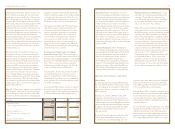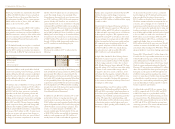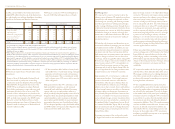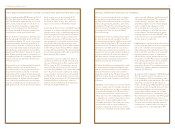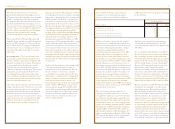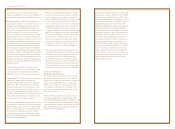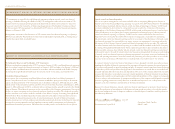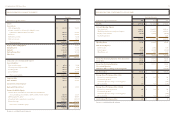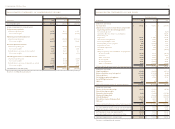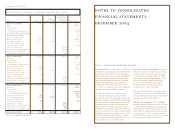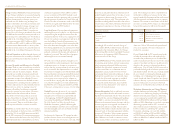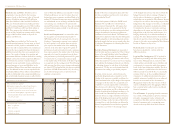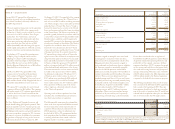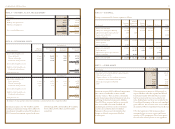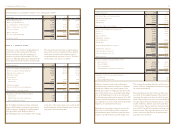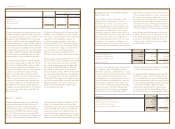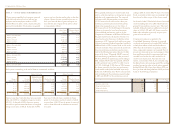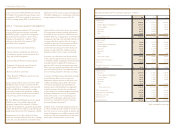North Face 2004 Annual Report Download - page 41
Download and view the complete annual report
Please find page 41 of the 2004 North Face annual report below. You can navigate through the pages in the report by either clicking on the pages listed below, or by using the keyword search tool below to find specific information within the annual report.
77vf corporation 2004 Annual Report
Foreign Currency Translation: Financial statements
of most foreign subsidiaries are measured using the
local currency as the functional currency. Assets and
liabilities denominated in a foreign currency are
translated into U.S. dollars using exchange rates
in effect at the balance sheet date, and revenues and
expenses are translated at average exchange rates
during the year. Translation gains and losses are
reported in Accumulated Other Comprehensive
Income (Loss). For foreign subsidiaries that use the
U.S. dollar as their functional currency, the effects of
remeasuring assets and liabilities into U.S. dollars is
included in the Consolidated Statements of Income.
Net transaction gains of $0.5 million in 2004,
$5.3 million in 2003 and $3.1 million in 2002 arising
from transactions denominated in a currency other
than the functional currency of a particular entity are
included in the Consolidated Statements of Income.
Cash and Equivalents includes demand deposits and
temporary investments that are readily convertible
into cash and will mature within three months of
their purchase.
Accounts Receivable and Allowance for Doubtful
Accounts: Trade accounts receivable are recorded at
invoiced amounts, less amounts accrued for returns,
discounts and sales incentive programs. Royalty
receivables are recorded at amounts earned based
on sales of licensed products, subject in some cases
to minimum amounts from individual licensees.
VF maintains an allowance for doubtful accounts
for estimated losses resulting from the inability of
customers and licensees to make required payments.
All accounts are subject to ongoing review for
ultimate collectibility. An allowance is provided
for specific customer accounts where collection is
doubtful and for the inherent risk in ultimate
collectibility of total balances due at any point
in time. Receivables are charged off against the
allowance when it is probable the amounts will
not be recovered. There is no off-balance sheet
credit exposure related to customer receivables.
Inventories are stated at the lower of cost or market.
Cost is determined on the first-in, first-out (“FIFO”)
method for 71% of total 2004 inventories and 66%
of total 2003 inventories. For remaining inventories,
cost is determined on the last-in, first-out (“LIFO”)
method (primarily due to Internal Revenue Service
conformity requirements where LIFO is used for
income tax purposes). The LIFO method is used
for jeanswear, wholesale sportswear and occupational
apparel inventories located in the United States and
Canada. The value of inventories stated on the LIFO
method is not significantly different from the value
determined under the FIFO method.
Long-lived Assets: Property, plant and equipment
and intangible assets are stated at cost. Depreciation is
computed using the straight-line method over the
estimated useful lives of the assets, ranging from 3 to
10 years for machinery and equipment and up to 40
years for buildings. Leasehold improvements are
amortized over the shorter of their estimated useful
lives or the lease term. Intangible assets, other than
those having indefinite lives, are amortized over their
estimated useful lives using straight-line or accelerated
methods consistent with the expected realization of
benefits to be received. The useful lives of property
and intangible assets are reviewed annually.
VF’s policy is to evaluate property, intangible assets
and goodwill for possible impairment at least annually
or whenever events or changes in circumstances
indicate that the carrying amount of such assets may
not be recoverable. An impairment loss is recorded
for property or intangible assets with identified useful
lives (and therefore are being amortized) if projected
undiscounted cash flows to be generated by the asset
or asset group are not expected to be adequate to
recover the assets’ carrying value. An impairment loss
is recorded for intangible assets with indefinite lives
(and therefore are not being amortized) or goodwill
if the assets’ carrying value is in excess of its fair value.
Goodwill represents the excess of costs over the
fair value of net tangible assets and identifiable
intangible assets of businesses acquired. Effective
at the beginning of 2002, VF adopted Financial
Accounting Standards Board (“FASB”) Statement
No. 142, Goodwill and Other Intangible Assets.
Under this Statement, goodwill and intangible
assets with indefinite useful lives are not amortized,
and other intangible assets are amortized over their
estimated useful lives.
In adopting the Statement, VF engaged an inde-
pendent valuation firm to assist management in its
review of the fair value of its business units and, where
Accordingly, VF recorded a noncash charge of
$527.3 million ($4.69 per diluted share), which was
recognized as the Cumulative Effect of a Change
in Accounting Policy in the Consolidated Statement
of Income at the beginning of 2002. There was no
income tax effect for this charge.
Accrued Self-insurance: VF is primarily self-insured
for employee group medical, workers’ compensation,
vehicle, property and general liability exposures.
Liabilities for self-insured exposures are accrued
on a discounted basis, in consultation with an
independent actuary, based on historical trends
and actuarial data for projected settlements of claims
filed and for incurred but not yet reported claims.
Accruals for self-insured exposures are included
in current and noncurrent liabilities based on
the expected period of payment. Excess liability
insurance has been purchased to cover claims in
excess of self-insured amounts.
Revenue Recognition: Sales to wholesale customers
are recognized when the risks and rewards of owner-
ship have been transferred, which is when the product
is received by the customer. Shipping and handling
costs billed to customers are included in Net Sales.
Allowances for estimated returns, discounts and sales
incentive programs are recognized as reductions of
sales when the sales are recorded. Sales incentive
programs with retailers include stated discounts and
discounts based on the retailer agreeing to advertise
or promote VF products. Sales incentive programs
directly with consumers include rebate and coupon
offers. Allowances are based on customer commit-
ments, specific product circumstances and historical
claim rates. Sales at VF-owned and operated retail
stores are recognized at the time of purchase of
products by consumers.
Cost of Goods Sold for VF-manufactured goods
includes all materials, labor and overhead costs
incurred in the production process. Overhead allo-
cated to manufactured product is based on the normal
capacity of our plants and does not include amounts
related to idle capacity or abnormal production
inefficiencies. Cost of Goods Sold for contracted or
purchased finished goods includes the purchase costs
and related overhead. In both cases, overhead includes
all costs related to obtaining the finished goods,
including costs of planning, purchasing, quality
control, freight and duties. For product lines having
a lifetime warranty, a provision for estimated future
repair or replacement costs, based on historical
experience, is recorded when these products are sold.
Marketing, Administrative and General Expenses
includes marketing and advertising, VF-operated
retail store costs, warehousing, shipping and handling
,
administrative and general expenses. Advertising
costs are expensed as incurred and totaled $314.1
million in 2004, $258.6 million in 2003 and $244.7
million in 2002. Advertising costs include cooperative
advertising payments made to VF’s customers as
direct reimbursement of advertising costs incurred
by those retailers for advertising VF’s products.
Cooperative advertising costs were $43.4 million
in 2004, $42.0 million in 2003 and $40.0 million
in 2002. Shipping and handling costs totaled $199.0
million in 2004, $183.3 million in 2003 and $177.0
million in 2002.
there was an indication that the recorded amount of
goodwill might be greater than its fair value, to assist
management in determining the amount of the
possible write-down in value. This evaluation indi-
cated that recorded goodwill exceeded its fair value at
several business units where performance had not met
management’s expectations at the time of their acqui-
sition. The resulting write-downs of goodwill were
attributable to differences between the fair value
approach under this Statement and the undiscounted
cash flow approach used under previous accounting
literature. The amount of write-downs, and the busi-
ness units accounting for the charges, are summarized
by reportable segment as follows (in thousands):
business segment amount business unit
Jeanswear $63,199 Latin American jeanswear
Intimate Apparel 109,751 European intimate apparel
Imagewear 295,128 Workwear and licensed knitwear
Other 59,176 Childrenswear


